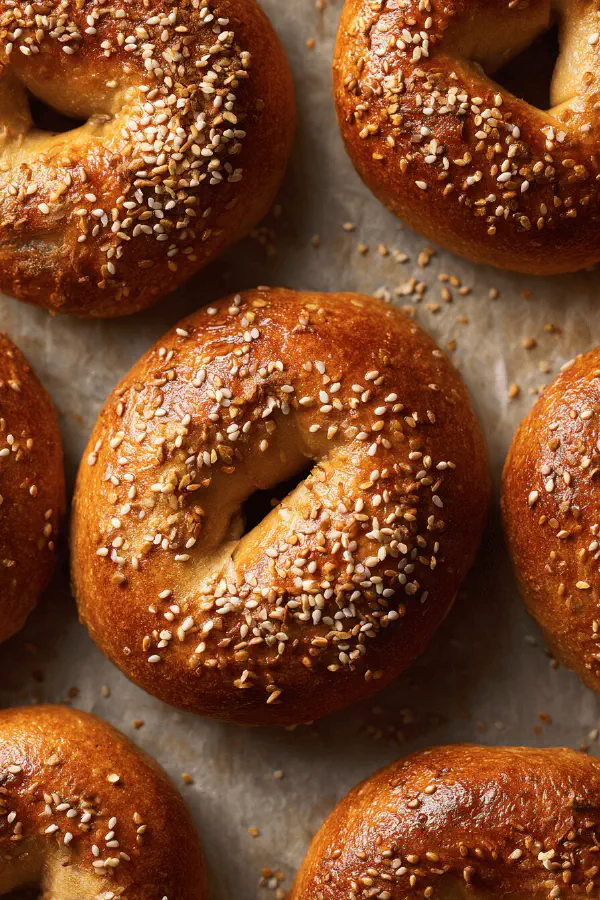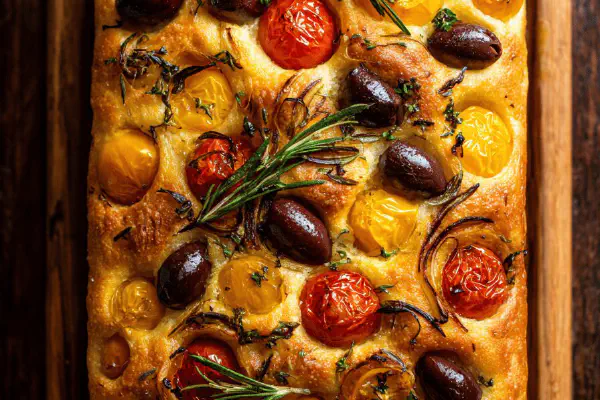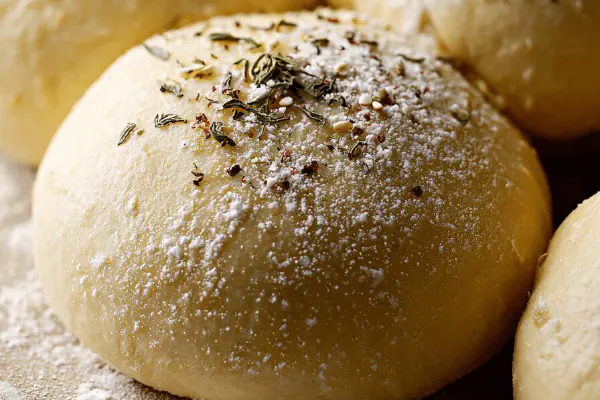Featured Recipe
Sesame Bagels with Molasses Twist

By Kate
"
Yeast-leavened bagels with a chewy crumb and a glossy crust dotted with sesame seeds. Uses molasses instead of honey for deeper flavor. Rolled ends sealed tight on rings for classic shape. Boiled briefly to set crust, then baked until golden. No dairy or eggs needed. Flour mix includes some bread flour for extra chew. A versatile base you can top with poppy or everything seasoning. Moisture cues and dough elasticity key to good texture.
"
Prep:
35 min
Cook:
50 min
Total:
Serves:
12 servings
bagels
baking
vegan
Introduction
Bagels. Dense, chewy bread rings with that shiny crust and signature springy bite. Not magic, but technique. Replacing some flour with bread flour amps chewiness. Molasses over honey here adds dark, earthy undertone—more robust aroma and color contrast with sesame. Dough silky but tacky shouldn’t stick like glue though; feel beneath fingers tells you if hydration’s right. Resting under oil stops crust drying or sticking to bowl. The boil gives crust snap, then baking finishes golden. The trick for sealing rings? Pinch then roll seam under palm firmly so they don’t pop open in water. Rest post shaping relaxes gluten, smoothing surface to hold shape. If bagels float too soon or get too puffy in boiling water, your yeast was too fierce or dough warmed up too much. Cool slightly if needed. Baking hot and low shelf concentrates heat for crust, avoiding too fast color. Real bagels need day-old chew but fresh is perfect for immediate munching before crumb tightens up while cooling. Seed topping sticks better on wetted dough after boiling. Store wrapped tightly to avoid drying. Reheat wrapped in damp towel briefly to revive chew. So many baker’s stumbles come from skipping rest phases or overhydrating dough—feel and timing over clock these days.
Ingredients
About the ingredients
Swapping molasses for honey darkens dough color and adds smoky complexity less saccharine—try maple syrup or agave if you want lighter notes. Bread flour is optional but improves gluten development for classic chew. If you only have AP flour, extend kneading another 2-3 minutes. Oil choice is forgiving; vegetable, canola, or mild olive oil all good. Measuring water by feel rather than exact volume helps: dough should be pliable but not sticky, tacky enough to hold moisture. Sesame seeds toast slightly in oven, giving nuttier flavor; try black sesame seeds or a mix with poppy seeds for variation. For gluten-free, use a strong blend of gluten-free flours with xanthan gum, but expect different texture and longer proof times. Keep your yeast fresh; expired yeast means bagels won’t rise well or pouch up during boil.
Method
Technique Tips
Key stages to watch: dough texture after kneading is glossy and stretchy, pulls away cleanly, tacky but not sticky. First rise is somewhat ‘puffy,’ dough grows but won’t double like bread dough. When shaping ropes, avoid tearing dough; if sticks, dust hands lightly but don’t dry skin or dough. Pinching and rolling seam under palm seals bagels, preventing water seepage that ruins shape. Boiling sets crust rapidly; timing is short and precise—longer boil can make bagel too soft or dense. Flip to brown evenly during boil. Drain bagels on slotted spoon to avoid soggy bottoms; shake gently to remove excess water. Baking one tray at a time ensures even heat exposure and crust development. Crust should firm to gentle tap, golden with seeds toasted. Resist opening oven mid bake to check—oven temp drop risks texture. Cooling lets crumb set; cutting too soon smashes internal structure. Bagels keep better in loose airtight containers; if staling, trick is reheating wrapped in damp towel for 5 minutes at moderate oven temp to restore moisture and chew. Skip wrapping when warm or bagels get soggy. Always test flour absorption and rise by feel instead of strict timer—kitchen temp changes dough’s pace. Bagels age beautifully when toasted for next-day use.
Chef's Notes
- 💡 Check dough consistency after kneading. Should be shiny, tacky but not sticky. If sticking, add a bit of flour.
- 💡 Watch boiling time. 2-3 minutes is key. Too long? Soft bagels. Too short? They won’t puff. Flip halfway for even cooking.
- 💡 For crusty bagels, bake on low rack. Hot heat hits bottom, giving nice rise and browning. Don’t rotate tray during baking.
- 💡 Seed toppings stick better on damp surfaces. Boil bagels, then sprinkle seeds right away. Helps keep toppings intact when baking.
- 💡 If bagels float too soon, they're over-proofed. Cool slightly before boiling. Adjust yeast for next batch if needed.
Kitchen Wisdom
Why is my dough too sticky?
May need more flour, or your water amount was off. Check feel; knead longer if everything's right.
Can I substitute molasses?
Maple syrup or agave works. But flavors change a bit. Stick with dark syrups for same depth.
What if my bagels are dense?
Under-kneaded dough or wrong yeast temp likely. Make sure dough passes the touch test. Keep kneading.
How to store bagels?
Airtight container works. Can freeze too. Not too long though. Reheat wrapped in a damp towel briefly.



